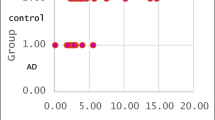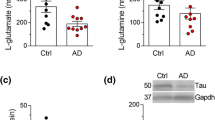Abstract
In order to test whether serum glutamine synthetase (GS) is of potential diagnostic value for Alzheimer’s disease (AD), we set up a study to compare serum GS concentrations between AD patients and control subjects. The study population (n = 165) consisted of AD patients (n = 94) and age-matched (n = 41) and age-unmatched (n = 30) control subjects. Serum GS analysis was performed by means of ELISA. No significant differences in serum GS levels were found between the AD group and age-matched controls. Age correlated positively with serum GS concentrations in AD patients and control subjects. This study suggests that serum GS levels have no diagnostic value for AD.
Similar content being viewed by others
References
Meister A (1974) Glutamine synthetase of mammals. In: Boyer PD (ed) The enzymes, vol 10. Academic Press, New York, pp 699–754
Suárez I, Bodega G, Fernández B (2002) Glutamine synthetase in brain: effect of ammonia. Neurochem Int 41:123–142
Finch CE, Cohen DM (1997) Aging, metabolism, and Alzheimer disease: review and hypotheses. Exp Neurol 143:82–102
Smith CD, Carney JM, Starke-Reed PE et al (1991) Excess brain protein oxidation and enzyme dysfunction in normal aging and Alzheimer disease. Proc Natl Acad Sci USA 88:10540–10543
Le Prince G, Delaere P, Fages C et al (1995) Glutamine synthetase (GS) expression is reduced in senile dementia of the Alzheimer type. Neurochem Res 20:859–862
Aksenov MY, Aksenova MV, Harris ME et al (1995) Enhancement of beta-amyloid A beta(1–40)-mediated neurotoxicity by glutamine synthetase. J Neurochem 65:1899–1902
Aksenov MY, Aksenova MV, Butterfield DA et al (1996) Glutamine synthetase-induced enhancement of beta-amyloid peptide A beta(1–40) neurotoxicity accompanied by abrogation of fibril formation and A beta fragmentation. J Neurochem 66:2050–2056
Aksenov MY, Aksenova MV, Carney JM et al (1997) Oxidative modification of glutamine synthetase by amyloid beta peptide. Free Radic Res 27:267–281
Varadarajan S, Yatin S, Aksenova M et al (2000) Review: Alzheimer’s amyloid β-peptide-associated free radical oxidative stress and neurotoxicity. J Struct Biol 130:184–208
Poon HF, Joshi G, Sultana R et al (2004) Antisense directed at the Abeta region of APP decreases brain oxidative markers in aged senescence accelerated mice. Brain Res 1018:86–96
Sato E, Oda N, Ozaki N et al (1996) Early and transient increase in oxidative stress in the cerebral cortex of senescence-accelerated mouse. Mech Ageing Dev 86:105–114
Contestabile A, Fila T, Bartesaghi R et al (2006) Choline acetyltransferase activity at different ages in brain of Ts65Dn mice, an animal model for Down’s syndrome and related neurodegenerative diseases. J Neurochem 97:515–526
Butterfield DA, Hensley K, Cole P et al (1997) Oxidatively induced structural alteration of glutamine synthetase assessed by analysis of spin label incorporation kinetics: relevance to Alzheimer’s disease. J Neurochem 68:2451–2457
Gunnersen D, Haley B (1992) Detection of glutamine synthetase in the cerebrospinal fluid of Alzheimer diseased patients: a potential diagnostic biochemical marker. Biochemistry 89:11949–11953
Tumani H, Shen G, Peter JB et al (1999) Glutamine synthetase in cerebrospinal fluid, serum, and brain. Arch Neurol 56:1241–1246
Takahashi M, Stanton E, Moreno JI et al (2002) Immunoassay for serum glutamine synthetase in serum: development, reference values, and preliminary study in dementias. Clin Chem 48:375–378
Burbaeva GS, Boksha IS, Tereshkina EB et al (2005) Glutamate metabolizing enzymes in prefrontal cortex of Alzheimer’s disease patients. Neurochem Res 30:1443–1451
Robinson SR (2001) Changes in the cellular distribution of glutamine synthetase in Alzheimer’s disease. J Neurosci Res 66:972–980
Kish S, Chang L, Dixon L et al (1994) Cerebellar glutamate metabolizing enzymes in spinocerebellar ataxia type I. Metab Brain Dis 9:97–103
Lavoie J, Giguere J, Layrargues G et al (1987) Activities of neuronal and astrocytic marker enzymes in autopsied brain tissue from patients with hepatic encephalopathy. Metab Brain Dis 2:283–290
Aluise CD, Sowell RA, Butterfield DA (2008) Peptides and proteins in plasma and cerebrospinal fluid as biomarkers for the prediction, diagnosis, and monitoring of therapeutic efficacy of Alzheimer’s disease. Biochm Biophys Acta 1782:549–558
Le Bastard N, Aerts L, Leurs J et al (2009) No correlation between time-linked plasma and CSF Aβ levels. Neurochem Int 55:820–825
Le Bastard N, Leurs J, Blomme W et al (2010) Plasma amyloid-beta forms in Alzheimer’s disease and non-Alzheimer’s disease patients. J Alzheimers Dis 21:291–301
Schneider P, Hampel H, Buerger K (2009) Biological marker candidates of Alzheimer’s disease in blood, plasma, and serum. CNS Neurosci Ther 15:358–374
McKhann G, Drachman D, Folstein M et al (1984) Clinical diagnosis of Alzheimer’s disease: report of the NINCDS-ADRDA work group under the auspices of Department of Health and Human Services Task Force on Alzheimer’s disease. Neurology 34:939–944
American Psychiatric Association (1994) DSM-IV: diagnostic and statistical manual of mental disorders, 4th edn. American Psychiatric Association, Washington
Román GC, Tatemichi TK, Erkinjuntti T et al (1993) Vascular dementia: diagnostic criteria for research studies. Report of the NINDS-AIREN international workshop. Neurology 43:250–260
Folstein M, Folstein S, McHugh PR (1975) Mini-Mental State: a practical method for grading the cognitive state of patients for the clinician. J Psychiatr Res 12:189–196
Engelborghs S, Sleegers K, Cras P et al (2007) No association of CSF biomarkers with APOEε4, plaque and tangle burden in definite Alzheimer’s disease. Brain 130:2320–2326
Andreasen N, Blennow K (2005) CSF biomarkers for mild cognitive impairment and early Alzheimer’s disease. Clin Neurol Neurosurg 107:165–173
Fei M, Jianghua W, Rujuan M et al. (2011) The relationship of plasma Aβ levels to dementia in aging individuals with mild cognitive impairment. J Neurol Sci doi:10.1016/j.jns.2011.03.005
Danh C, Benedetti S, Dostert P (1985) Age-related changes in glutamine synthetase activity of rat brain, liver and heart. Gerontology 31:95–100
Launer LJ, Andersen K, Dewey ME et al (1999) Rates and risk factors for dementia and Alzheimer’s disease: results from EURODEM pooled analyses. EURODEM incidence research group and work groups. European studies of dementia. Neurology 52:78–84
Acknowledgments
This research was supported by the Special Research Fund of the University of Antwerp; Stichting Alzheimer Onderzoek; the Thomas Riellaerts Research Fund; the Institute Born-Bunge; the agreement between the Institute Born-Bunge and the University of Antwerp; the central Biobank facility of the Institute Born-Bunge/University of Antwerp; Neurosearch Antwerp; the Fund for Scientific Research - Flanders (FWO-F); the Interuniversity Attraction Poles (IAP) program P6/43 of the Belgian Federal Science Policy Office; the Methusalem excellence grant of the Flemish Government, Belgium. NLB is a PhD fellow of the Research Foundation - Flanders (FWO-F). The authors acknowledge the technical assistance of E. De Leenheir, G. Van de Vijver, F. Franck and J. Luyckx, the administrative assistance of S. Hicketick, W. Wittebolle, and A. Eykens, and the clinical staff involved.
Author information
Authors and Affiliations
Corresponding author
Rights and permissions
About this article
Cite this article
Vermeiren, Y., Le Bastard, N., Clark, C.M. et al. Serum Glutamine Synthetase Has No Value as a Diagnostic Biomarker for Alzheimer’s Disease. Neurochem Res 36, 1858–1862 (2011). https://doi.org/10.1007/s11064-011-0504-4
Accepted:
Published:
Issue Date:
DOI: https://doi.org/10.1007/s11064-011-0504-4




